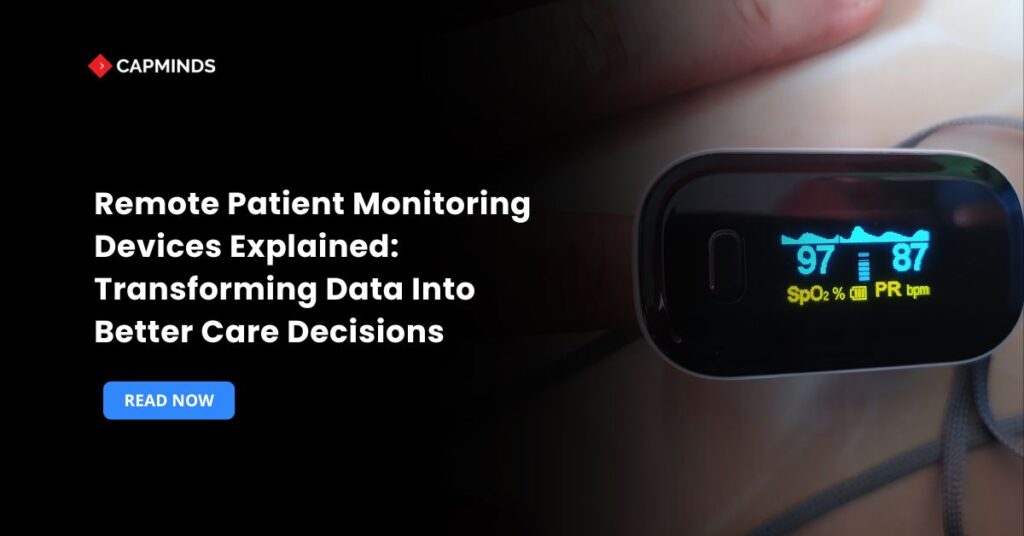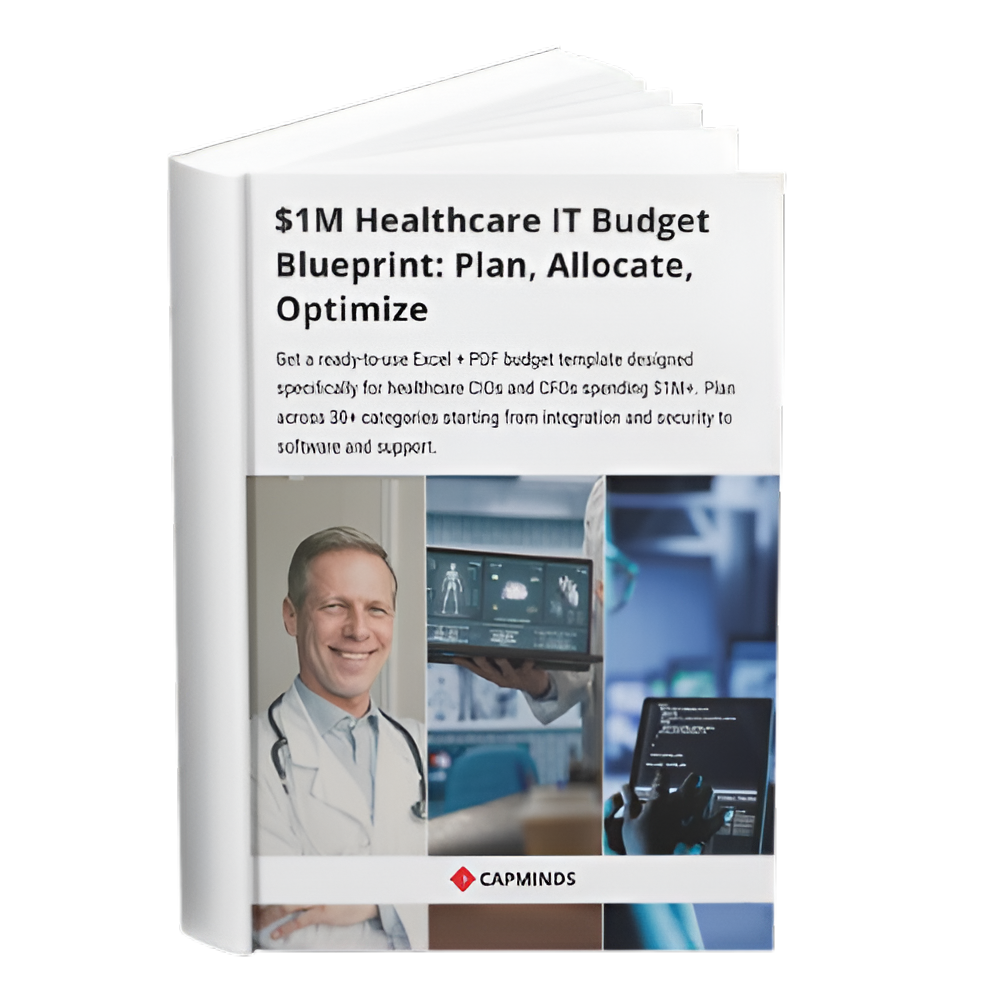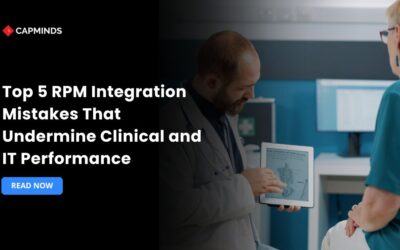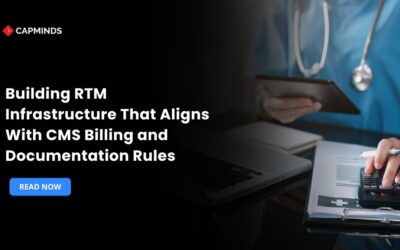Remote Patient Monitoring Devices Explained: Transforming Data Into Better Care Decisions
Remote Patient Monitoring devices have progressed from small studies to the forefront of linked healthcare. RPM in healthcare is rapidly becoming essential for hospitals, payers, and physician organizations alike, as reimbursement grows and consumers adopt digital health solutions.
In this blog, you’ll learn about the various types of RPM devices, examine how they transform the way chronic care monitoring is conducted, and highlight how wearable medical technology can facilitate the creation of continuous, data-driven care pathways.
The Significance of Remote Patient Monitoring Devices
RPM devices collect clinical vitals where they occur, such as in beds, kitchens, and workplaces, rather than in exam rooms, which is typically once or twice a year. As a result, patients feel supported in between visits, and physicians have real-time knowledge of the interactions between comorbidities, medicine, and lifestyle.
Value-based contracts now incentivize results rather than encounter volume. RPM initiatives assist health systems in avoiding expensive emergency admissions and readmission fees by identifying deterioration early. Because of this, progressive organizations see RPM in healthcare as a financial strategy as well as a therapeutic need.
RPM’s Advantages in Healthcare
Chronic care monitoring is strengthened by RPM devices. Subtle patterns that might normally go undetected until the next doctor visit are revealed by continuous blood pressure or glucose monitoring. They also increase patient involvement. Patients are encouraged to adopt better habits and improve their drug adherence when they observe changes in their figures.
RPM programs also make care coordination easier. When measurements surpass safe levels, automatic alarms are sent to nurses, enabling proactive outreach. Then, rather than organizing paper logs during telehealth follow-ups, doctors examine trend dashboards. Ultimately, the same real-time data is used by the patient, caregiver, and doctor.
- Early clinical deterioration detectionhttps://www.capminds.com/chronic-care-management/
- Reduced ED visits and hospital stays
- Medication titration based on data
- Increased retention and satisfaction of patients
- Enhanced performance in quality measurement
Different RPM Device Types
The kinds of RPM devices available on the market vary according to the differences in clinical objectives. The main categories you will come across are listed below:
- Cardiovascular sensors include linked weight scales for managing heart failure, cellular blood pressure monitors, and six-lead patch ECGs.
- Continuous glucose monitors and smart glucometers that upload blood-sugar curves for diabetic coaching are examples of metabolic trackers.
- Bluetooth pulse oximeters and portable spirometers are examples of respiratory monitors for COPD or extended COVID surveillance.
- Neurological wearables like remote EEG headbands for managing epilepsy and wristbands that detect seizures.
- Multi-parameter gadgets such as smartwatches and rings that combine activity, temperature, SpO2, and heart rate measurement into a stylish design.
Wearable Medical Technology
Conventional medical accessories can occasionally come across as scary and clinical. On the other hand, wearable health technology, such as fitness bands, biosensing rings, and smartwatches, blends in well with everyday activities. They are good at gathering high-frequency data without interfering with daily living.
Consumer-grade wearables now provide clinical-grade accuracy for specific measures, including overnight SpO₂ or single-lead ECG. Programs generate a comprehensive picture of the patient’s state by combining these insights with sensors unique to a certain ailment. Cardiologists may provide context and continuity by, for instance, having a patient with heart failure wear a wristwatch for rhythm monitoring and a linked scale for fluid balance.
Why wearable technology increases uptake
- Familiar user interface and user-friendly applications
- Push alerts and gamified objectives that encourage habit change
- Smooth data synchronization with LTE or Bluetooth
- Patients like to wear fashionable form factors
Related: Most Popular Health Monitoring Devices Used in 2025
Creating a Successful Program for Chronic Care Monitoring
Shipping gadgets is only one aspect of launching RPM for chronic illnesses. To be successful:
- Describe the clinical routes and assign distinct responsibilities to nurses, pharmacists, or health coaches, and map which vital signs result in which treatments.
- Automate documentation by transferring data straight into progress notes; you may reduce alert fatigue and do away with human entry.
- Inform patients and their caretakers, which helps them provide multilingual quick-start manuals, unboxing calls, and round-the-clock technical assistance.
- Assess ROI to verify the business case, monitor decreases in hospitalizations, drug changes, and patient-reported results.
A multi-condition strategy should be considered because chronic diseases rarely travel alone. For example, a single platform may integrate CGMs for diabetes with blood pressure cuffs for hypertension, resulting in a single physician dashboard and patient log-in.
Navigating Common Implementation Challenges
When logistics go wrong, even the greatest remote patient monitoring devices are ineffective. Engagement might be derailed by complicated enrollment procedures, delivery delays, and connectivity issues.
- Network adaptability – For older populations without Wi-Fi or in rural locations, use devices with cellular fallback.
- EHR interoperability – Give preference to suppliers who provide prebuilt connections with top health IT systems or FHIR APIs.
- Data governance – To safeguard patient privacy, implement role-based access, encryption, and HIPAA compliance.
- Alignment of Reimbursement – To guarantee steady income, stay up to date on CPT codes for RPM setup, monitoring, and device supply.
Organizations may speed up the time to value and increase clinician confidence by tackling these obstacles early on.
Checklist for RPM Vendor Selection
Use this short screening list to screen prospective partners before signing any contracts:
- Clinical Validation – Research publications and, if relevant, FDA approval
- Device Logistics – Shipment, inventory control, and return reverse logistics
- Patient Experience – Live support, accessibility features, and multiplatform applications
- Analytics and reporting – Exportable quality-measure reports and dashboards that can be customized.
The capacity to incorporate additional circumstances and devices without having to start from scratch.
From Devices to Decisions: Scale RPM with CapMinds
Turn Remote Patient Monitoring Devices into measurable outcomes. CapMinds designs, implements, and scales RPM in healthcare, connecting wearable health devices, workflows, and billing so teams act sooner and document faster.
- RPM program design and condition-specific care pathways
- FDA-vetted RPM devices: sourcing, kitting, and reverse logistics
- Patient onboarding, education, and multilingual live support
- 24/7 monitoring, alert triage, and nurse escalations
- HL7/FHIR integration with your EHR and care platforms
- CCM coordination, care plans, and adherence coaching
- Telehealth visits embedded within RPM encounters
- HIPAA compliance, CPT billing enablement, and performance analytics
We align the types of RPM devices to the right populations, cut setup friction, and surface insights to reduce readmissions and improve chronic care monitoring.
Book a consult to map use cases, data flows, and KPIs, launch an RPM, CCM, and telehealth program clinicians trust and patients use.




